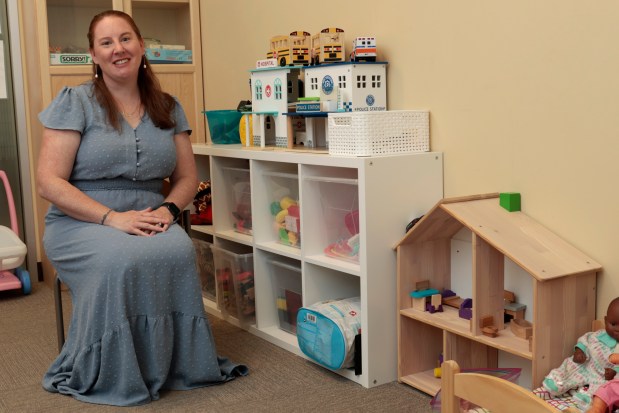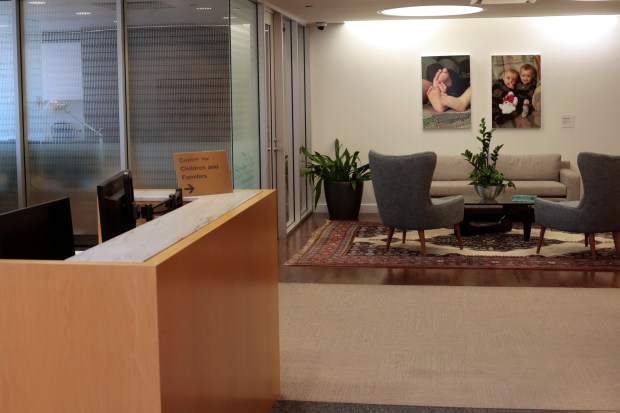Did you know babies can get depressed?
Andria Goss, associate vice president of clinical and community services at the Erikson Institute, a graduate school for social work, early childhood education and child development programs, said people are astonished when they learn and appreciate that fact.
“Babies experience everything as a bodily feeling: If a parent is stressed, depressed and/or anxious, the baby is picking up on that,” she said. “Imagine a mom who has her own stresses and sometimes she’s able to focus on her baby and other times there’s an interaction, she’s angry, or not attuned to the baby, not doing the stuff that engages the baby. They have this on-off, on-off repeatedly. The baby doesn’t know what to do with that because the baby is working hard to get smiles, elicit cooing and it’s not happening. At a certain point, with all those failed attempts, the baby stops trying … and withdraws.”
Goss said that although that’s an extreme example, it illustrates how babies pick up stressors from their environment and don’t know what to do with them. When such interactions become chronic, that can create challenges in the parent-child relationship.
The Erikson Institute’s Center for Children and Families offers in-person and online mental health services to children as young as newborns and their families in and around Chicago from its River North and Little Village locations, and has been doing so for decades.
According to the Centers for Disease Control and Prevention, 1 in 6 U.S. children ages 2 to 8 years has a diagnosed mental, behavioral or developmental disorder and among that group, boys are more likely than girls to have such a disorder.
“What we do at the Center for Children and Families is more a preventive measure,” Goss said. “The expectation is that babies are going to assimilate into my life. But that’s not their job. That’s our job (as adults and parents).”
When families and schools identify that something may not be working for a child, they get in touch with CCF, whose focus is relationship-based therapy. The center tries to connect the dots when there is a disconnect and a child is unable to regulate emotions and less able to explore and learn.
“When we’re looking at mental health and psychiatric difficulties, it’s a nature-nurture situation — we call it a vulnerability stress model,” said Sally Weinstein, licensed clinical psychologist and associate director at the University of Illinois Center on Depression and Resilience. “We all are born into this world with some biological vulnerabilities that we inherit. And these may interact with our environment in ways that are either protective for our development, or may be harmful for our development. It is that combination that affects development, even of young kids.”
The goal of therapy is to strengthen attunement — a person’s ability to be aware of and respond to a child’s needs — to strengthen the child’s and caregiver’s capacities, their relationship and how a caregiver is able to experience and parent the child.
“What you want for your baby, being attuned to where your baby is and what he/she needs? We’re unpacking those types of things,” Goss said.
CCF gets to the heart of that through play. Licensed clinical social worker and CCF Director Sara Phou said the bulk of the families they serve have children age 3 to 6 who get 18 months of therapy. The center connects caregivers with therapists to glean the challenges in the caregiver-child relationship prior to the child being brought in. When the child comes to a CCF location, therapists observe the child playing with their caregiver as a clinician takes note of how play is unfolding, the themes, the feelings involved.

“(Children) use play to develop, to understand the world, but also as a way to help share how they’re thinking and feeling,” Phou said.
If, for instance, a child plays with cars and races through a city knocking down blocks featuring a good guy and a bad guy, the child may be trying to make sense of good and bad in the world. “We can join them in their play, and help the car be regulated,” Phou said. “Using play as an extension of themselves and working through it there might provide a port of entry, a way for them to internalize it.”
Every behavior is a communication, Goss said. “We try to pull insight into what the kid is struggling with,” she said. “We want to evaluate cognitive skills, motor skills, social and emotional skills … it’s not a one size fits all.”
Goss said the center meets families where they are and works with them from perspectives that consider race, culture and their environment. By following their child’s lead and putting in the work in therapy, caregivers enable change in their child’s life.
Engaging in therapy aids caregivers in regulating themselves so they can help regulate their child. And caregivers and parents feel more confident in understanding what’s happening with their child. Once family units feel empowered, parents can feel a sense of efficacy, and feel like whatever happens, they can deal with it.
“Play is so important for development. … It’s that power of connection for the little one around who they are, you want to connect with them around something that is of value to them,” Phou said. “There’s research around 10 minutes a day: If you follow your child’s lead and play with them for 10 minutes a day, that is all they need to build that connection. … That is going to be a huge protective factor for their mental health.”
Weinstein agrees that the short amount of time can help children build trust with parents and help parents build confidence and competence. Phou said 10 minutes of daily play can be more beneficial than hours of planned family time every couple of months.
“Finding moments where there’s joy and delight, in who they are, and it feels good for both of you, is going to help the relationship and help that connection,” Phou said.
But how does a parent know when an issue escalates to something that needs intervention, especially when there’s such a broad range in how kids develop and so many symptoms of mental health difficulties that resemble what normal childhood looks like: mood variability, big emotions, irritability, all which can be part of a child’s experience?
Weinstein said parents should be looking for any sort of disruption or deviation from typical milestones, like toilet training, talking and walking, and keep in mind feedback from those around your child such as preschool teachers or day care staffers who may notice if your child is struggling.
“While kids brains are changing so much and that’s why they are having these big emotions and having a hard time regulating emotions, the great news is that the brain is still developing and very malleable,” Weinstein said. “So the more intervention, love and support, the more we can modify some of the difficulties.”
Early in the pandemic, Weinstein and Goss both noticed an uptick in referrals for mental health help and youths reaching out to access support themselves without their parents’ urging. The shift shows a growing acceptance of therapy, they said.
“When there’s a challenge around mental health for a young child, the treatment isn’t just for the child,” Phou said. “We’re working with both the caregiver and the child together and supporting that caregiver to help them think about what they might be bringing to the equation and how they can support their child and what their child is bringing to the equation.”
Goss added that can be challenging because caregivers have to look at themselves in relation to their child and how they are engaging and connecting in order to effect change.
For first-time parents, who may face sleep deprivation, burnout or a lack of feeling effective, Weinstein said their mental health is key. She suggests parents consider getting support by talking with other new parents or with their pediatrician. Since parents are the experts on their children, they are also the first line of defense when it comes to intervention.
“There are no hard and fast rules, even if a teacher says I see your child is struggling, that is not a reason to panic, but always a reason to seek out and gain support and more understanding about ways you could help your child,” Weinstein said.




